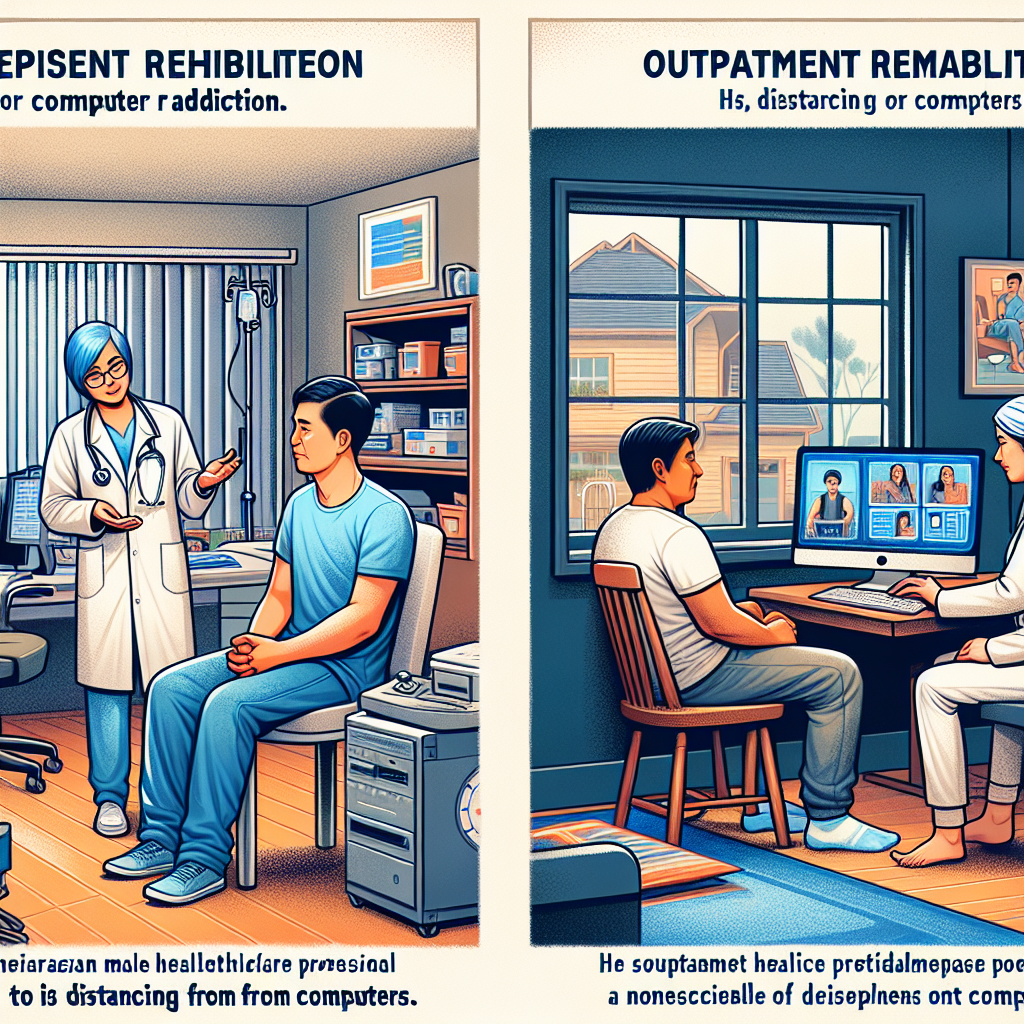-
Table of Contents

“Choosing the Right Path: Inpatient vs. Outpatient Rehab for Computer Addiction”
Introduction
Computer addiction, a growing concern in the digital age, necessitates effective treatment strategies to mitigate its impact on individuals’ lives. Rehabilitation programs, both inpatient and outpatient, offer structured environments to address this issue, each with distinct approaches and benefits. Inpatient rehab provides an immersive, controlled setting where individuals can focus entirely on recovery, free from external distractions and triggers. Conversely, outpatient rehab allows individuals to maintain their daily routines while receiving treatment, offering flexibility and the opportunity to apply coping strategies in real-world scenarios. Comparing these two modalities reveals critical insights into their efficacy, accessibility, and suitability for different levels of addiction severity, ultimately guiding individuals and healthcare providers in selecting the most appropriate path to recovery.
Inpatient vs. Outpatient Rehab for Computer Addiction: Which is More Effective?
When grappling with computer addiction, choosing the right rehabilitation approach can be a pivotal step toward recovery. Both inpatient and outpatient rehab programs offer unique benefits and challenges, and understanding these can help individuals make informed decisions about their treatment journey. Inpatient rehab, often referred to as residential treatment, involves staying at a facility for a designated period, typically ranging from a few weeks to several months. This immersive environment provides a structured routine, constant supervision, and immediate access to professional support. On the other hand, outpatient rehab allows individuals to live at home while attending scheduled therapy sessions and support groups, offering greater flexibility and the ability to maintain daily responsibilities.
One of the primary advantages of inpatient rehab is the removal of external distractions and triggers. By residing in a controlled environment, individuals can focus entirely on their recovery without the temptation of easy access to computers and the internet. This setting fosters a sense of community among residents, who often share similar struggles, creating a supportive network that can be crucial for emotional healing. Additionally, the intensive nature of inpatient programs means that individuals receive comprehensive care, including individual therapy, group counseling, and various therapeutic activities designed to address the underlying causes of addiction.
Conversely, outpatient rehab offers a different set of benefits that can be equally compelling. The flexibility of outpatient programs allows individuals to continue working, attending school, or fulfilling family obligations while receiving treatment. This can be particularly advantageous for those who cannot afford to take extended time off from their daily lives. Moreover, outpatient rehab encourages the application of coping strategies in real-world settings, providing individuals with the opportunity to practice and refine their skills in managing computer use within their everyday environment. This real-time application can be instrumental in building long-term resilience and preventing relapse.
However, the effectiveness of each approach can vary depending on the individual’s specific circumstances and the severity of their addiction. For those with severe computer addiction, inpatient rehab may offer the intensive support and structure needed to break deeply ingrained habits. The round-the-clock care and immediate access to medical and psychological support can be critical in the early stages of recovery. In contrast, individuals with milder forms of addiction or those who have already made significant progress in their recovery journey might find outpatient rehab to be a more suitable option. The ability to integrate treatment into their daily lives can help reinforce positive behaviors and support sustained recovery.
Ultimately, the decision between inpatient and outpatient rehab should be guided by a thorough assessment of the individual’s needs, preferences, and the resources available. Consulting with healthcare professionals who specialize in addiction treatment can provide valuable insights and help tailor a plan that maximizes the chances of successful recovery. It is also important to consider the availability of support systems, such as family and friends, who can play a crucial role in the recovery process.
In conclusion, both inpatient and outpatient rehab programs offer distinct advantages that can be effective in treating computer addiction. The choice between the two should be based on a careful evaluation of the individual’s situation, the severity of the addiction, and the level of support required. By making an informed decision and committing to the chosen path, individuals can embark on a transformative journey toward reclaiming control over their lives and achieving lasting recovery.
Cost and Convenience: Weighing Inpatient and Outpatient Rehab Options for Computer Addiction
When grappling with computer addiction, choosing the right rehabilitation program is crucial for recovery. Both inpatient and outpatient rehab options offer unique benefits and challenges, particularly when considering cost and convenience. Understanding these factors can help individuals and their families make informed decisions that best suit their needs and circumstances.
Inpatient rehab programs, also known as residential treatment, require individuals to stay at a facility for a specified period, typically ranging from 30 to 90 days. This immersive environment provides a structured routine, constant supervision, and immediate access to professional support. The cost of inpatient rehab can be substantial, often including accommodation, meals, therapy sessions, and other amenities. While insurance may cover some expenses, out-of-pocket costs can still be significant. However, the comprehensive nature of inpatient care can be invaluable for those with severe computer addiction, offering a controlled setting free from the triggers and distractions of daily life.
On the other hand, outpatient rehab programs allow individuals to live at home while attending scheduled treatment sessions. This flexibility can be particularly appealing for those who have work, school, or family commitments. Outpatient programs are generally more affordable than inpatient options, as they do not include the costs associated with residential care. Insurance coverage for outpatient treatment is also more common, making it a financially viable option for many. Despite the lower cost, outpatient rehab can still provide effective support through individual therapy, group sessions, and educational workshops.
When weighing the convenience of each option, it is essential to consider the individual’s specific circumstances and the severity of their addiction. Inpatient rehab offers a distraction-free environment, which can be crucial for those who struggle to control their computer use in their daily lives. The structured schedule and constant supervision can help individuals develop healthier habits and coping mechanisms. However, the commitment to an inpatient program can be challenging for those with significant personal or professional responsibilities.
Conversely, outpatient rehab provides the flexibility to maintain daily routines while receiving treatment. This can be particularly beneficial for individuals who have a strong support system at home and can manage their computer use with some external guidance. The ability to apply newly learned skills in real-time, within the context of everyday life, can also be advantageous. However, the success of outpatient rehab largely depends on the individual’s motivation and ability to resist temptations outside of treatment hours.
Ultimately, the decision between inpatient and outpatient rehab for computer addiction should be based on a thorough assessment of the individual’s needs, the severity of their addiction, and their personal and financial circumstances. Both options have their merits, and the right choice will vary from person to person. It is essential to consult with healthcare professionals who can provide personalized recommendations and support throughout the recovery process.
In conclusion, while cost and convenience are significant factors in choosing between inpatient and outpatient rehab for computer addiction, the most critical consideration is the individual’s unique situation. By carefully evaluating the benefits and challenges of each option, individuals and their families can make informed decisions that pave the way for successful recovery. With the right support and commitment, overcoming computer addiction is not only possible but also a transformative journey towards a healthier, more balanced life.
Q&A
1. **Question:** What is the primary difference in the treatment environment between inpatient and outpatient rehab for computer addiction?
**Answer:** The primary difference is that inpatient rehab requires patients to stay at a treatment facility full-time, providing a structured environment with 24/7 support, while outpatient rehab allows patients to live at home and attend scheduled treatment sessions, offering more flexibility and the ability to maintain daily responsibilities.
2. **Question:** How does the level of support differ between inpatient and outpatient rehab for computer addiction?
**Answer:** Inpatient rehab offers intensive, round-the-clock support and supervision, which can be crucial for severe cases of computer addiction. Outpatient rehab provides periodic support through scheduled therapy sessions, which may be suitable for individuals with milder addiction or those who have a strong support system at home.
Conclusion
In comparing inpatient and outpatient rehab for computer addiction, it is evident that both approaches offer distinct advantages and cater to different needs. Inpatient rehab provides a structured environment with intensive, round-the-clock care, which can be crucial for individuals with severe addiction or those who require a break from their daily environment to focus on recovery. Outpatient rehab, on the other hand, offers greater flexibility, allowing individuals to maintain their daily responsibilities while receiving treatment. This approach can be more cost-effective and less disruptive to one’s life. Ultimately, the choice between inpatient and outpatient rehab should be based on the severity of the addiction, the individual’s personal circumstances, and the level of support they require. Both methods can be effective, but the best outcomes are often achieved when the treatment plan is tailored to the specific needs of the individual.



